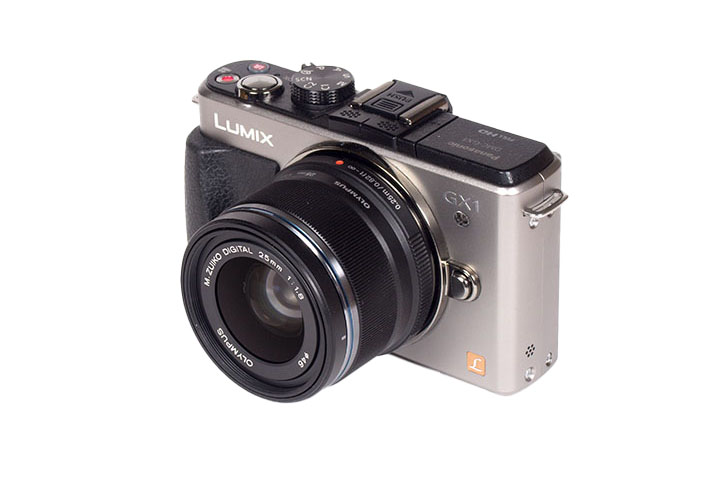
There has been a revival of standard prime lenses in recent years and there’s also no shortage of them in the Micro-Four-Thirds system. The Panasonic/Leica Summilux 25mm f/1.4 ASPH comes into mind or the Voigtlander Nokton 25mm f/0.95. However, these are rather pricey lenses. In early 2014 Olympus released its first entry into this market segment – the Olympus M.Zuiko 25mm f/1.8. The lens follows the tradition of the M.Zuiko 45mm f/1.8 in being not overly expensive yet fast enough to make a difference compared to the fast zoom lenses of the system.
Please note that while the maximum aperture of f/1.8 is certainly fast with respect to light gathering the depth-of-field capabilities remain limited. On an MFT camera you are are effectively losing about two f-stops in this respect compared to the classic full format. Thus the M.Zuiko 25mm f/1.8 is equivalent to a “50mm f/3.6” as far as the creative potential is concerned. However, this is still sufficient for quite shallow depth-of-field images when keeping a close distance to the main subject in a scene.
The M.Zuiko 25mm f/1.8 is almost indistinguishable from its “longer” cousin (45mm f/1.8). This is good news because the build quality is on similarly high level. The small and light weight lens body looks like high-quality metal but it is actually made of plastic parts based on a metal mount. A barrel-shaped lens hood is included.

The AF motor of the Zuiko has also been optimized for movies (“Movie-Still-Compatible” or MSC). It offers fast and silent AF operations. Manual focusing works “by-wire” so there’s no direct mechanical coupling. From a real world perspective there’s little difference compared to conventional manual focusing though.
| Specifications | |
|---|---|
| Equiv. focal length | 50mm (full format equivalent) |
| Equiv. aperture | f/3.6 (full format equivalent, in terms of depth-of-field) |
| Optical construction | 9 elements / 7 groups inc. 2xaspherical elements |
| Number of aperture blades | 7 (circular) |
| min. focus distance | 0.25m (1:8) |
| Dimensions (L x W) | 57.8x42mm |
| Weight | 137 |
| Filter size | 46mm |
| Hood | Barrel-shaped, bayonet mount, included |
| Other features | – |
Distortion
The M.Zuiko lens produces only a slight degree of barrel distortion (~0.5%) which is barely noticeable in field conditions. This applies to uncorrected RAW images as well.

Vignetting
The lens shows only a fairly high degree of vignetting (1EV/f-stops) at fully open aperture. Stopping down reduces the light falloff but traces remain even at f/5.6. The uncorrected RAW figures are slightly worse but this may simply relate to a different tonal curve compared to JPEGs generated by the camera.

MTF (resolution)
The M.Zuiko delivered quite impressive results in the MTF lab. The image center is excellent straight from the maximum aperture. The borders as well as the corners are on a good to very good level. Stopping down has a marginal effect till you reach diffraction-affected apertures (f/8 and beyond). The peak performance is reached between f/2.2 and f/2.8. The field curvature is quite low.
The tested sample had a very good centering quality.
Please note that the MTF results are not directly comparable across the different systems!
Below is a simplified summary of the formal findings. The chart shows line widths per picture height (LW/PH) which can be taken as a measure for sharpness. If you want to know more about the MTF50 figures you may check out the corresponding Imatest Explanations

Chromatic Aberrations (CAs)
Lateral CAs (color shadows at harsh contrast transitions) are just slightly visible with an average pixel width of around 1px at the image borders. This is not disturbing though.

Bokeh
The quality of the bokeh (out-of-focus blur) is an important characteristic for large aperture lenses. The Olympus lens does a good job here but it’s not without flaws.
Out-of-focus highlights have a circular shape throughout most of the image field. However, the inner highlight zone shows a rather busy sub-structure.

On the positive side, the rendition of the out-of-focus blur in the focus transition zone is very smooth.

Sample Images
The Olympus M.Zuiko 25mm f/1.8 is undoubtedly a high quality lens with a tiny form factor.
The resolution characteristic is very even across the relevant aperture range. The center quality is mostly excellent followed by a good to very good outer image region. Lateral CAs are low which contributes to the high quality perception. Image distortions are negligible - also in RAW mode. On the downside, there's some light falloff in the corners at large aperture settings. The bokeh is generally smooth although the rendition of out-of-focus highlights could be better.
The build quality is very good although some may criticize the lack of "substance", but this is simply a highly compact and ultra light-weight lens. The Zuiko lens uses a Movie-Still-Compatible (MSC) AF which is both fast and silent. Whether movie enthusiasts are really using auto-focusing is a different question but there are no drawbacks for conventional photography anyway.
So as far as both optical and mechanical qualities are concerned, there's little to complain really. We just wished that Olympus would have chosen a somewhat faster max. aperture. A 25mm f/1.8 prime feels a little too limited in terms of its depth-of-field potential (in the scope of the MFT format). That being said an even faster aperture would have driven up the price and most users are surely already struggling with the high price of the competing Panasonic/Leica Summilux 25mm f/1.4 ASPH so Olympus' decision to stay at f/1.8 may be reasonable.
-
Optical Quality
-
Build Quality
-
Price / Performance

